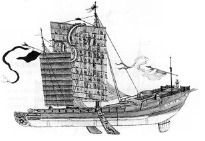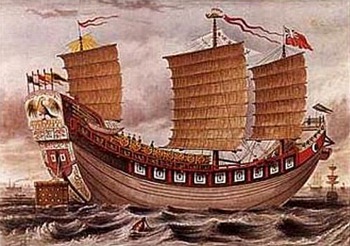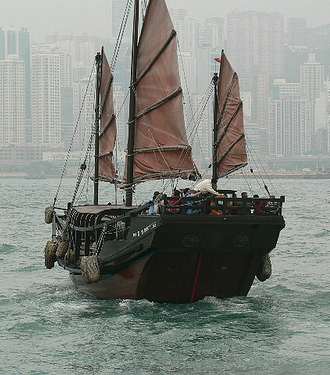The junk
 For centuries the Chinese junk was the most seaworthy vessel of all nations. It was the only type of vessel that was constructed in watertight compartments and would still float if two of its compartments were flooded. In a time when ships sailed into uncharted seas this was a most useful design.
For centuries the Chinese junk was the most seaworthy vessel of all nations. It was the only type of vessel that was constructed in watertight compartments and would still float if two of its compartments were flooded. In a time when ships sailed into uncharted seas this was a most useful design.
An early description of junks in the 3rd century book "Strange Things of the South" by Wan Chen states that junks were capable of carrying 700 people together with 260 tons of cargo. it explains that "these ships sail without avoiding strong winds and dashing waves, by the aid of which they can make great speed" because their "oblique rig, which permits the sails to receive from one another the breath of the wind, obviates the anxiety attendant upon having high masts." The image on the left shows a junk from the Song dynasty (13th century).
The original junks were square-rigged, which meant that they could not tack against the wind but had to follow the prevailing winds. In the Indian Ocean the Southwest Monsoon blows from June to October and the Northeast Monsoon from December to April, so the Chinese junks sailed westward to the trading ports of India, Arabia and Africa early in the year and returned to their home ports with their goods during the second half of the year.
When Cheng Ho took his fleet to continents far and wide his junks also followed the prevailing winds, but some of his junks (his "treasure ships") were much larger than the normal trading junks.
Chinese junks travelled long distances in later centuries as well. The illustration below shows the Keying, a Chinese junk that "according to the Boston Evening Transcript of 1847 [...] came to Boston ... and was moored at the Charles River Bridge on November 18 of that year. It was open for exhibition, and on Thanksgiving Day there were four to five thousand people who visited the junk. The December issue of the same paper reported that a Chinese of rank was on board that junk. He received visitors and showed them many curiosities from China. The gentleman must have been a merchant and there might have been other Chinese merchants on board as well. Keying sailed to other cities after its stop at Boston." (Chu, 1987).

Illustrations: public domain (Wikipedia)
Junks are still seen occasionally in Chinese waters. They are now rigged in a way to also allow a course close to the wind. The photo below shows a modern tourist junk in Hong Kong harbour.

Photo: S. Regan; public domain (Flickr)
Reference
Chu, D. J. C. (1987) Chinese in Massachusetts:
their experiences and contributions. Chinese Culture Institute.
home
 For centuries the Chinese junk was the most seaworthy vessel of all nations. It was the only type of vessel that was constructed in watertight compartments and would still float if two of its compartments were flooded. In a time when ships sailed into uncharted seas this was a most useful design.
For centuries the Chinese junk was the most seaworthy vessel of all nations. It was the only type of vessel that was constructed in watertight compartments and would still float if two of its compartments were flooded. In a time when ships sailed into uncharted seas this was a most useful design.
